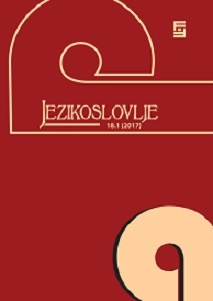Genitive of negation in the Croatian language
Genitive of negation in the Croatian language
Author(s): Diana StolacSubject(s): Syntax, Historical Linguistics, Descriptive linguistics, South Slavic Languages, Philology
Published by: Filozofski fakultet, Sveučilište Josipa Jurja Strossmayera, Osijek
Keywords: genitive of negation; direct object; Croatian syntax; English syntax;
Summary/Abstract: A direct object in Croatian is an object in the accusative case or an object in the genitive case which is interchangeable with the accusative. There are two types of direct object in the genitive case – the partitive genitive and the genitive of negation (Slavic genitive). The conditions that have to be met for the genitive of negation to be used are that the predicate verb has to be transitive, and that the sentence has to be negative. Therefore, the genitive of negation can only be realized in negative sentences in which it is synonymous with the accusative, while in the positive sentences the direct object is exclusively in the accusative case.The literature on the genitive of negation primarily deals with its origin and original meanings – partitive, ablative (Meillet, 1897), its position in the Indo-European noun case system (Heinz 1965), and its status in particular Slavic languages (Trávníček 1938; Breznik 1943; Hausenblas 1958; Harrer-Pisar-kowa 1959; Gortan-Premk 1962; Heinz 1965; Hlavsa 1975; for Croatian: Feleszko 1970; Menac 1979; Vince-Marinac 1992; Stolac 1993; Stolac – Horvat-Vlastelić 2004; for Croatian-English relations see: Zovko Dinković 2013). This morphosyntactic fact is a feature of Slavic languages (which is why it is also called the Slavic genitive) in which it has different qualitative characteristics (stylistically marked/unmarked, interchangeable with the accusative with/without a difference in meaning, non-interchangeable with the accusative). There are no equivalent syntactic structures outside the Slavic language family.This paper comments on the differences between the Croatian and English syntax which make direct translation of the genitive of negation impossible and require the translator to employ translation strategies that enable him or her to preserve all of its features (amplified negation, stressed negation, stylistic markedness). Since the genitive of negation is more frequent in older Croatian texts, and especially in the contemporary spoken discourse, it is also necessary to approach it from the diachronic perspective. The corpus for this segment of this study consists of plays by the Kajkavian comediographer Tituš Brezovački (1757–1805). Apart from translation, this is also an issue in teaching Croatian as a foreign language, as the change of cases between the positive and negative sentence confuses the users of Croatian as a foreign language. The relationship between the following examples is discussed: Vidim budućnost./Ne vidim budućnost. (neutral affect)/Ne vidim budućnosti. (marked affect), and their possible translations: I don't see the future./I see no future.
Journal: Jezikoslovlje
- Issue Year: XVIII/2017
- Issue No: 1
- Page Range: 101-123
- Page Count: 23
- Language: English

